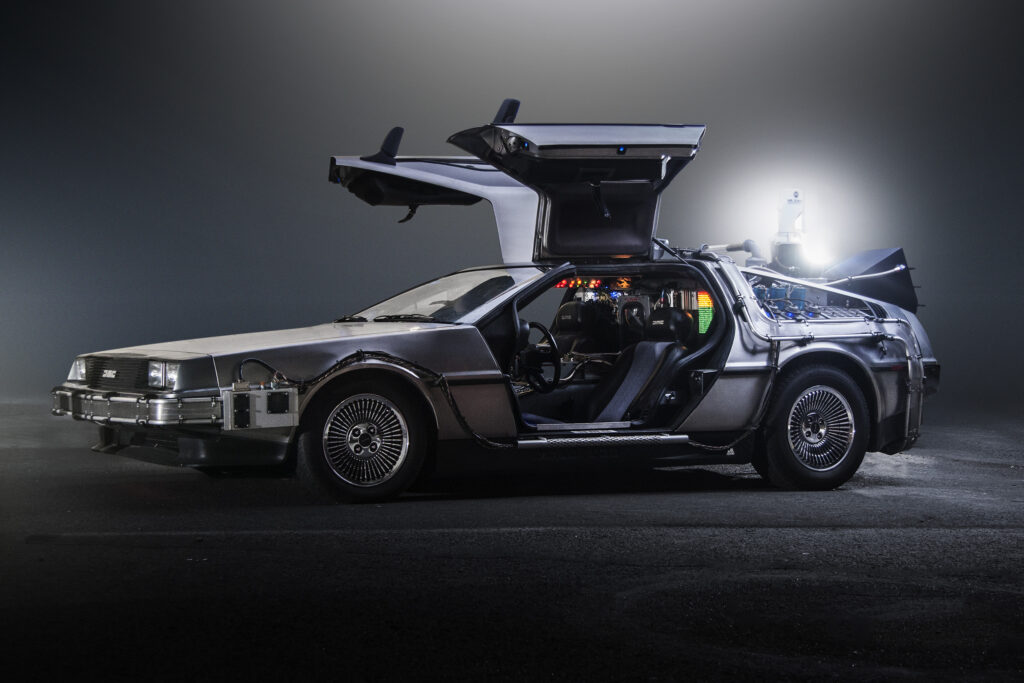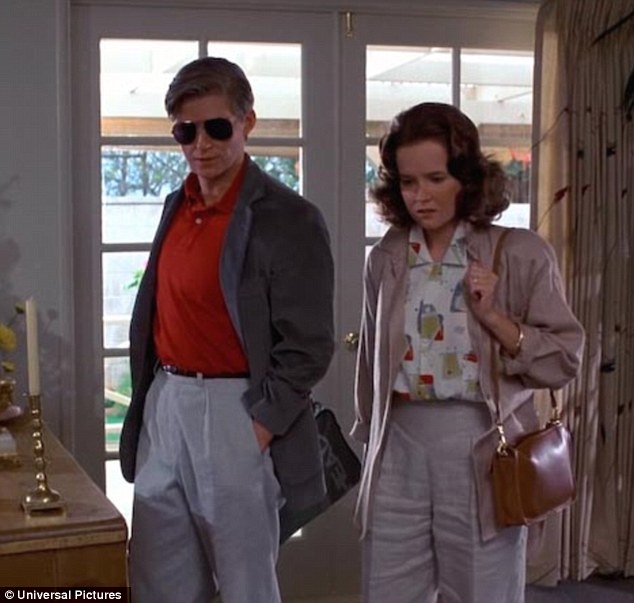In the Back to the Future franchise, the DeLorean time machine is a time travel device made by retrofitting a DMC DeLorean vehicle with a flux capacitor. The car requires 1.21 gigawatts of power and needs to travel 88 miles per hour (142 km/h) to initiate time travel.
The driver is seated inside the DeLorean (except the first time, when the remote control is used), and turns on the time circuits by turning a handle near the gear lever, activating a unit containing multiple fourteen- and seven-segment displays that show the destination (red), present (green), and last departed (yellow) dates and times. After entering a target date with the keypad inside the DeLorean, the operator accelerates the car to 88 miles per hour (141.6 km/h), which activates the flux capacitor. As it accelerates, several coils around the body glow blue/white while a burst of light appears in front of it. Surrounded by an electrical current similar to a Tesla coil, the whole car vanishes in a flash of white/blue light seconds later, leaving a pair of fiery tire tracks.

A digital speedometer is attached to the dashboard so that the operator can accurately gauge the car’s speed. Various proposals have been brought forth in the past by fans of the movie franchise for why the car has to be moving at 88 mph to achieve temporal displacement, but actually the production crew chose the velocity simply because they liked how it looked on the speedometer, modified for the movie. The actual speedometer on the production DeLorean’s dashboard only goes up to 88 mph, and the car itself was criticized for being underpowered by a V6 engine.

Outside the vehicle you can see an implosion of plasma as the vehicle disappears, leaving behind a trail of fire aligned with the DeLorean’s tires (which can also appear in midair), while occupants within the vehicle see a quick flash of light and instantaneously arrive at the target time in the same spatial location (relative to the Earth) as when it departed. In the destination time, immediately before the car’s arrival, three large and loud flashes occur at the point from which the car emerges from its time travel. After the trip, the exterior of the DeLorean is extremely cold, and frost forms from atmospheric moisture all over the car’s body. Vents on the back heat the vehicle after time travel.
Time travel in this film represents and shows the viewer many perspectives that the writer had about people. One is that people can change. It is embodied by George McFly. The suggestion is that if we can identify our mistakes and our limitations, we can correct them and improve ourselves. The other theme is that we don’t change. That life has chosen a path for us and we’re just along for the ride. This is also presented, in cinematic irony, through George McFly. Despite this massive interruption into his life by a futuristic person, leading to a significant amount of personal growth, he ultimately ends up with the same result as before. Same wife, same children, same home, just a higher-paying, more prestigious occupation.


This is a Robert Zemeckis film fronted financially by Steven Spielberg. Like many but not all Spielberg works, it is heavier on pizzazz than story. Zemeckis clearly likes the car and the flux capacitor. He likes the discomfort between Marty and his teenage parents. He does very well with those concepts.
Cinema, even to this day in films such as “Doubt,” tends to regard the JFK assassination as the dividing line between Happy America and Disturbed America. In the ’50s, we didn’t have problems with drugs, alcohol, divorce or social concerns such as civil rights, gay rights or war protests. The writer also displays sexism through Marty’s impressive girlfriend who is left out of the 1955 sequence and serves as little more than momentary eye candy. Her on-screen time at the beginning is so limited, we have no reason to long to return to her as Marty does. He also has the big character development in the George character, Marty’s father, and not Lorraine. Both characters could have easily had major character developments throughout the movie since both were on screen a lot, but he choose George to be the one to change into the “hero” character against Biff. An alternative to that story would have been for Loraine to stand up against the Biff character to show that women can stand up for themselves. Although, at the end of the movie, you can see that she has become happier and healthy from the beginning of the movie in the old present where she was unhealthy and depressed.
He shows that a typical 1955 family had very 1980s-ish concerns. We learn that Lorraine likes to drink and smoke, that her brother will become a career criminal, that George is something of a pervert, that people did smoke pot. Zemeckis twice makes a statement about African Americans. One is about a diner busboy in 1955 envisioning he could someday become mayor. We already know that will happen, and that the mayor in question seems a bit of a flake. Dreams of being a scientist apparently would be too serious for this film. Then there is the curious matter of the Marvin Berry band. The goal here is to add to Marty’s hipness credentials. The results are poor where as the black band members are the only people in the film smoking pot and that Chuck Berry is learning a “new sound” from a suburban white teen of Hill Valley, CA.